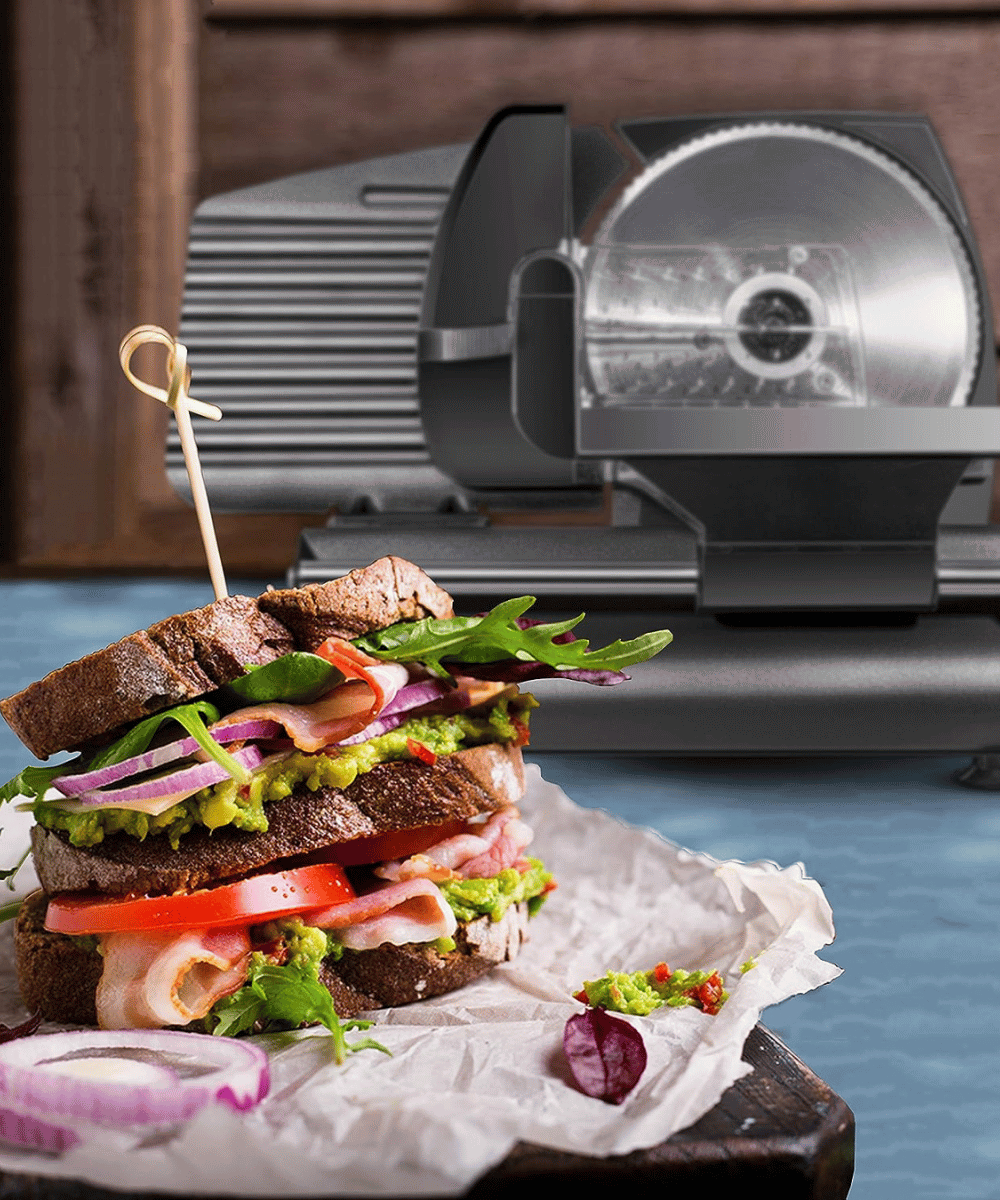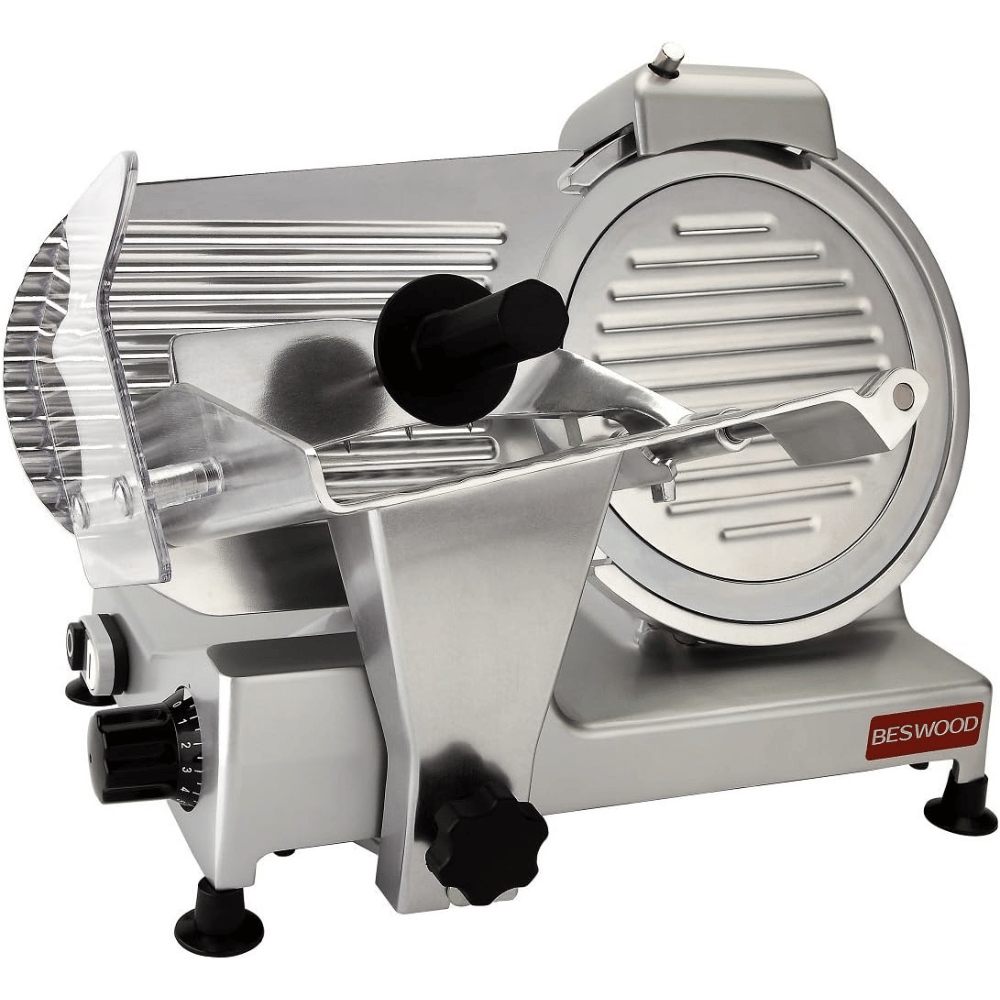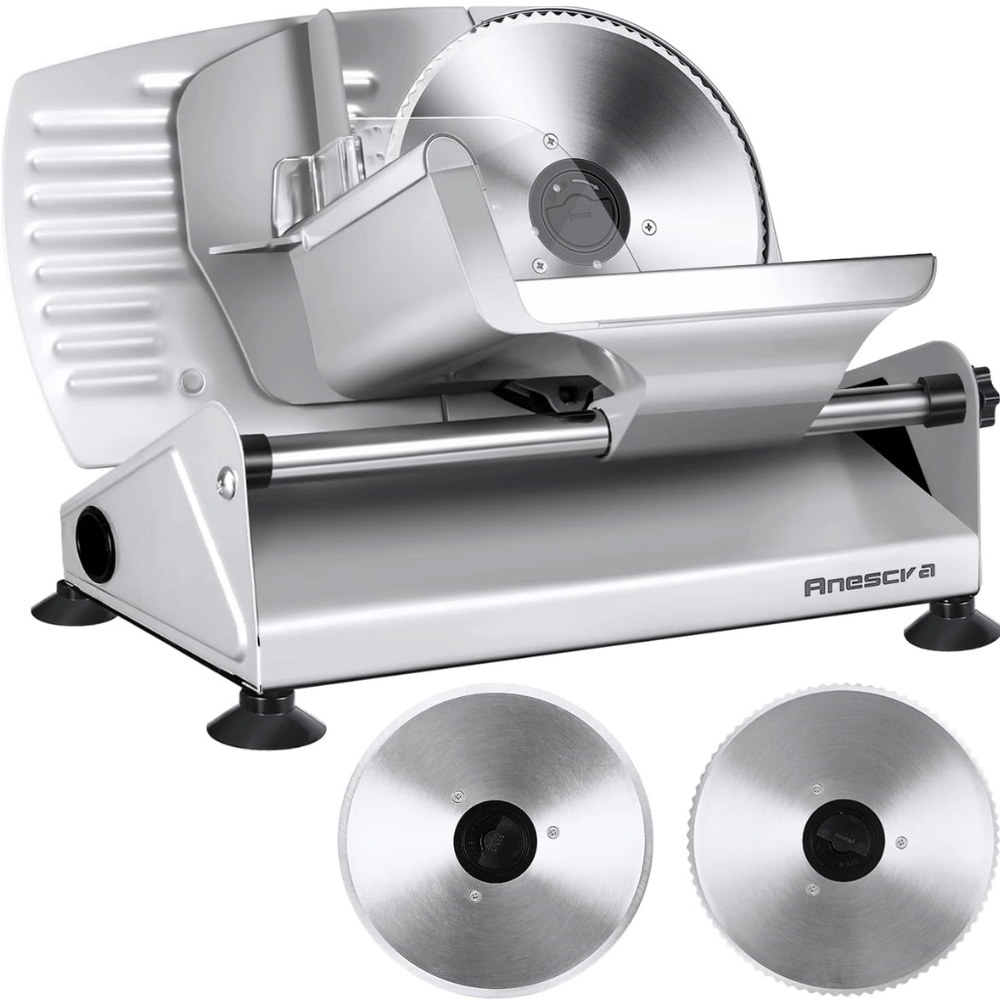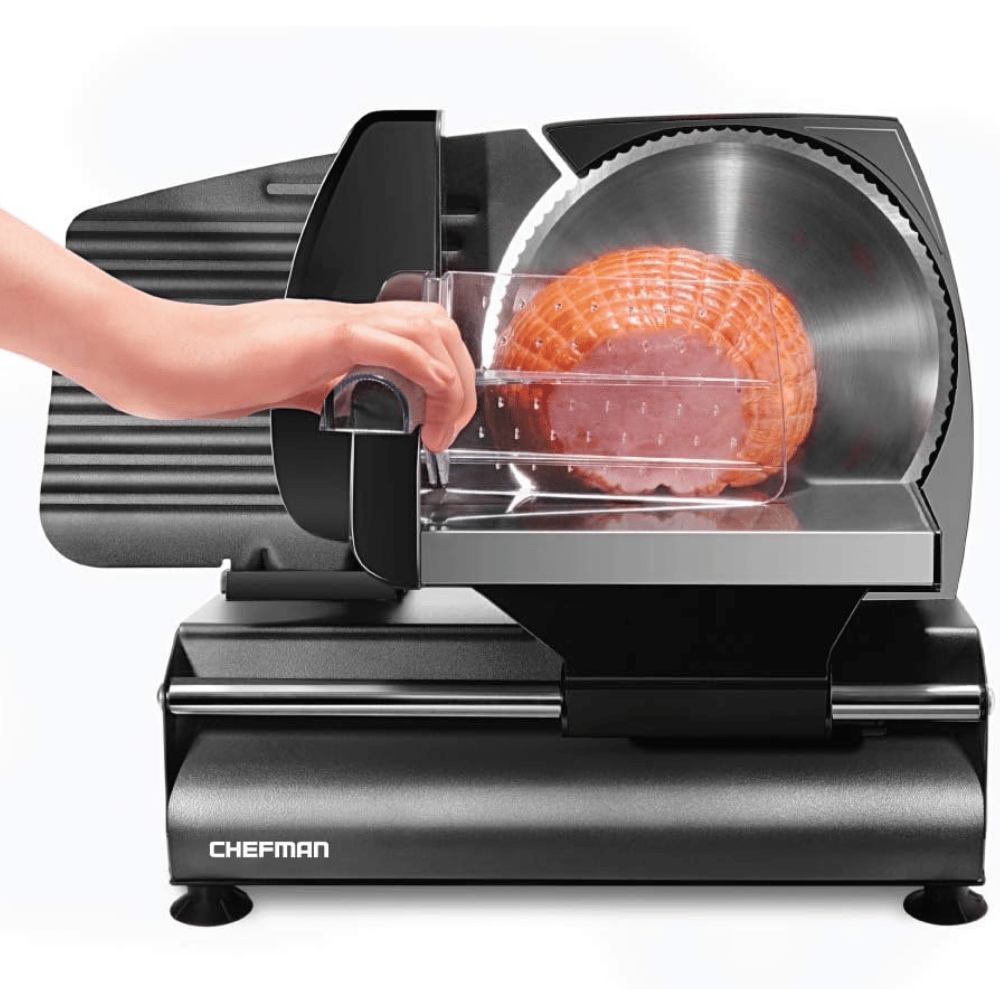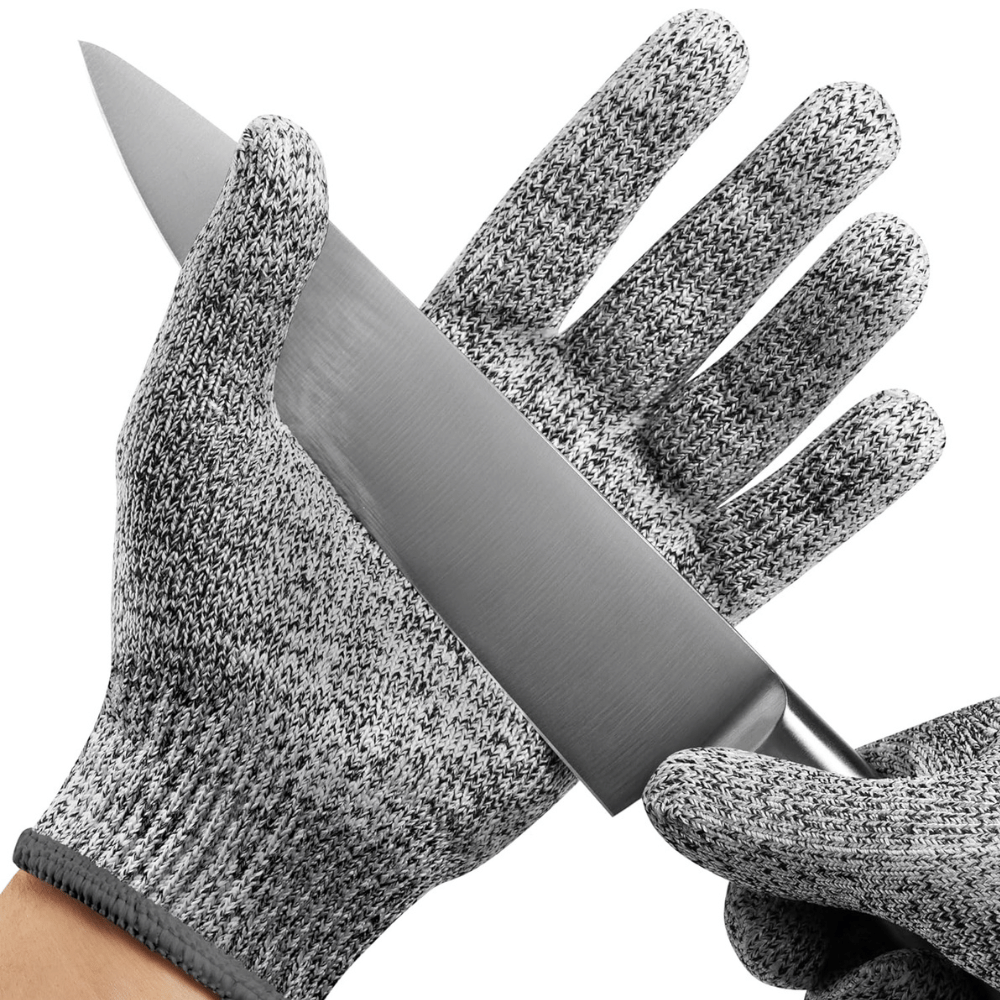Have you ever found yourself wishing for perfectly sliced meats that rival those of your local deli? Look no further than owning a home meat slicer!
Not only will you save money by purchasing whole cuts of meat, but you'll also have the control to slice your meats to your desired thickness.
Plus, it's a great addition to any kitchen for hosting events or making meal prep a breeze. Ditch the pre-packaged and overpriced deli meats and upgrade to slicing your meats at home.
Your taste buds (and wallet) will thank you.
With so many options on the market, it can be overwhelming to know where to start. That's why we've done the research and compiled a list of the best meat slicers and their standout features.
Whether you're a beginner or a seasoned chef, these slicers are sure to make meal prep a breeze.
From adjustable thickness settings to easy-to-clean designs, these slicers have it all. So, pour yourself a glass of wine and get ready to take your at-home cooking game to the next level!
What to Look for When Shopping for a Meat Slicer
There are a few things to keep in mind while you're shopping.
You, of course, want to ensure that the slicer is not only easy to use, but also durable and made of high-quality materials. A stainless steel blade will be durable and resist corrosion. You will also want to be aware of the adjustable thickness options to ensure it will meet your meat slicing needs.
Safety features are a consideration when dealing with potentially dangerous equipment such as an electric deli slicer. Features such as a locking food carriage and safety on/off switch are important safety features to consider.
Another important factor to consider is whether it is easy to clean. You will need to keep it very clean, so the easier, the better.
After all, this is an investment and you want it to last for a long time.
Let's take a look at a few of the top options and their features.
Best Meat Slicers and Their Features
BESWOOD 10" Premium Electric Meat Slicer
- Large 10" high carbon, chromium-plated steel smooth blade needs less frequent sharpening
- Built-in stainless steel blade stone sharpener
- Powerful 240 W, 1/3 HP electric motor
- non slip rubber feet
- For commercial and home use
- Hand wash only, easy to clean
The Downside:
Users say the stainless steel blade can be removed for cleaning.
Users also recommend caution in handling the sharp blades. Cut-proof gloves are recommended.
Anescra Electric Deli Food Slicer
- 200W electric motor
- Two 7.5 inch stainless steel blades included (1 serrated blade, 1 smooth blade)
- Compact, lightweight cast aluminum for practical home slicing needs
- non slip suction cup feet prevent sliding during the slicing process
- Easy disassembly for easy cleaning
The Downside:
Some users say the smaller size limits the size of meats that can be cut.
Chefman Die-Cast Electric Meat & Deli Slicer
- Very affordable meat slicer
- 180W motor
- 7.5 inch stainless steel, serrated blade
- Die cast aluminum housing is compact and lightweight
- Non slip feet
- Easy to clean
- 1-year warranty by Chefman
The Downside:
Some users say the food pusher slide control is not sturdy.
Users also caution the blade is sharp and to use caution when slicing and when cleaning - a cutting glove is recommended
Maintenance Tips for Keeping Your Electric Meat Slicer in Good Condition
Hey there! If you're a meat lover like me, you know a good meat slicer is essential in any kitchen. It makes meal prep faster and easier. But did you know that proper maintenance is the key to keeping your meat slicer working like new?
Here are a few tips to keep in mind.
First, be sure to clean it thoroughly after each use with warm, soapy water and a soft cloth. Always be careful with the sharp blade when removing and cleaning. Additionally, regularly lubricating your slicer's moving parts will prevent rust and ensure smooth, seamless slicing.
Finally, it's important to have your meat slicer professionally serviced at least once a year to keep it in tip-top shape.
By following these simple maintenance tips, you'll be sure to enjoy your trusty meat slicer for years to come!
Electric Meat Slicer Safety
Safety should always be your top priority when using a meat slicer. Follow the same basic safety guidelines as when using knives in the kitchen.
Here are some pointers to keep in mind:
- Always Use a Pusher When You Slice Meat: Never use your hand to push the meat through the slicer. Instead, always use a pusher for protection. This reduces the risk of your fingers coming into contact with the blade.
- Wear Cut-Resistant Gloves: When operating the meat slicer, it's advisable to wear cut-resistant gloves for an added layer of safety.
- Unplug When Not in Use: Always unplug the slicer when it's not in use or when you're cleaning it. This reduces the risk of accidental activation.
- Keep Blade Sharp: A dull blade can be more dangerous than a sharp one. Ensure regular sharpening to avoid mishaps.
- Follow Manufacturer's Instructions: Last but not least, always adhere to the manufacturer's instructions for the safe usage and maintenance of your slicer.
By keeping these safety tips in mind, you can ensure efficient and accident-free use of your meat slicer.
Delicious Meals With Your New Meat Slicer
Are you ready to take your cooking to the next level? Investing in a meat slicer can revolutionize your meal prep game.
With its ability to perfectly slice meats and cheeses, and vegetables, the possibilities are endless for delicious recipes with a meat slicer for home use.
Imagine perfectly slicing your favorite deli meats and cheeses for sandwiches, efficient slicing of a variety of meats and cheeses for a charcuterie board, or even perfectly uniform slices of vegetables for a stir-fry and many other foods.
Don't settle for pre-sliced meat when you can elevate your cooking with the help of a meat slicer. Let your culinary creativity run wild with this versatile kitchen tool.
Now that you know all the basics of shopping for, using, and caring for an electric meat slicer, what are you waiting for?
Get to the store and bring home your very own and start slicing up delicious meats for delectable meals!
Whether you’re planning to treat yourself to authentic thin sliced meat deli sandwiches, hosting an event with lots of guests or just hoping to make meal prep a breeze, investing in the right type of meat slicer allows you to cut down on preparation time and effort while producing beautiful pieces of thin-sliced perfection every time.
Questions About Home Meat Slicers
Q: What size is the best meat slicer for home use?
When it comes to choosing the ideal size of meat slicer for home use, there are a few important things to consider. The most important factor is what types of food prep you plan on completing with your machine; if you plan on slicing just thin meat slices or small portions at once, then a smaller meat slicer with a 7.5 inch blade size will do.
On the other hand, if you're looking to slice larger pieces and longer roasts, then opt for a mid-size or large meat slicer with a 9" or larger blade size.
It's also important to think about the size of your kitchen and storage space when selecting a meat slicer. If you have limited countertop space and cabinets in which to store your machine, then a compact meat slicer is a great choice so it is lightweight enough to easily put away when not in use.
Q: How big of a meat slicer do you need to slice bacon?
Good question! The size of the meat slicer you need depends on how thick you want your bacon slices to be. Generally, a 9-inch model can handle slicing bacon up to ¼ inch thick. If you're looking for thinner slices (⅛ inch or thinner), then 11-inch and 12-inch models will do the trick nicely.
Beyond the blade size of the slicer, it's important to look for one that has an adjustable thickness so you can customize your meat slicing to your exact specifications.
A reliable motor is also crucial as thicker cuts require more power and torque than smaller cuts.
Sturdy construction is essential - some meats are tougher than others and require elements such as stainless steel blades and a tilted food carriage to ensure high quality slices every time, even after prolonged use.
Q: Is it better to slice meat hot or cold?
When it comes to slicing meat, the best option really depends on what type of meat you’re working with.
Generally speaking, hot-slicing works better for tender cuts that can be cooked quickly and have a tender texture after cooking, such as steak or lamb chops.
Cold-slicing is usually preferred for larger, tougher cuts of meat like prime rib roasts or pork shoulders that require longer cook times and benefit from being sliced before cooking.
There are some Benefits to HOT SLICING:
1) Hot slicing allows you to achieve paper-thin slices that can be browned in a pan or grill very easily! This is great if you want efficient slicing of uniform pieces without having to put too much effort into it.
2) You’re less likely to end up with an uneven texture because hot meats tend to hold their shape better when cut while they are still warm. 3) Since hot meats contain more moisture than cold ones, they also release less fat when sliced—which makes them easier to work with and less greasy overall.
4) Due to their higher temperature, hot meats also require shorter cooking times because their cells will already be partially cooked by the time they hit your plate!
On the other hand, here are some key benefits of COLD SLICING:
1) Cold-sliced meats tend to retain more moisture throughout the process—resulting in juicier proteins once cooked!
2) It’s much easier (and safer!) To get precise and consistent slices when working with cold meats because their structure has been solidified by cooling them in advance—this makes them easier to handle without worrying about jagged edges or squished pieces.
3) Since cold-sliced pieces won't start cooking until placed over a heat source, this method gives you more control over how long each piece will take to cook before serving!
4 ) Lastly, since fat tends to release faster from cold meats, this technique Is ideal If You want crunchy yet juicy results!
Q: Will a meat slicer cut frozen meat?
Yes, a meat slicer can cut frozen meat! But you'll want to take a few extra steps to make sure your sliced meats come out perfectly and don't damage the blade.
Here are some tips on how to use a meat slicer safely and effectively with frozen meats:
Invest in a good-quality commercial-grade meat slicer that is designed for cutting tough cuts of frozen meats - these blades will be made from superior materials, such as stainless steel, that won’t dull or bend when slicing through frozen foods.
Make sure the blade is sharp and not too dull as this could cause it to snag or tear at the frozen pieces of meat while slicing.
Put your piece of frozen meat carefully over the center of the machine's blade where it will receive even pressure during slicing, then secure it into place with metal food holders if needed (you always want your hands away from any moving parts).
This also prevents slipping that can occur while trying to slice through delicate items like pre-frozen beef steaks and roasts.
Start slow - build up speed gradually as you get used to using the electric meat slicer for cutting frozen items like steaks, chops etc., and allow time for thawing/melting between cuts if necessary (the general rule is that you should only slice about two 2 inch thick slices per minute).

